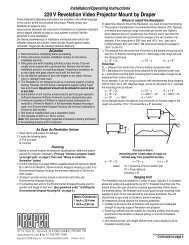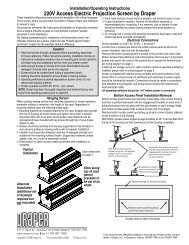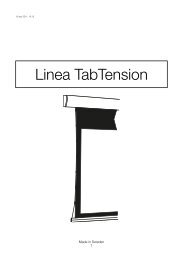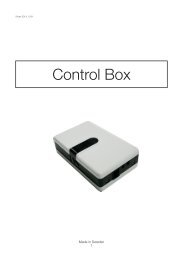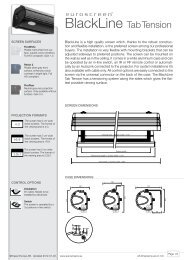Draper's Product Guide for Visual Communication - Draper Group Ltd
Draper's Product Guide for Visual Communication - Draper Group Ltd
Draper's Product Guide for Visual Communication - Draper Group Ltd
Create successful ePaper yourself
Turn your PDF publications into a flip-book with our unique Google optimized e-Paper software.
Rigid Rear Projection Screens<br />
CineScreen ®<br />
<strong>Draper</strong>’s Optical Coatings and Tints<br />
<strong>Draper</strong> Cinescreens differ from any other rigid rear projection screens in two<br />
extremely important respects:<br />
• Cinescreen optical coatings have been <strong>for</strong>mulated to provide inherent<br />
abrasion resistance. No other manufacturer offers you this protection.<br />
• Only <strong>Draper</strong> offers you a choice of six different optical coatings, each of<br />
which is available in your choice of three unique optical tints. With a <strong>Draper</strong><br />
Cinescreen, you can select the optimum combination of optical coating<br />
and tint based upon your projection equipment, audience seating pattern,<br />
desired contrast level, screen aspect ratio, ambient light level and aesthetic<br />
considerations. Only <strong>Draper</strong> offers you this versatility.<br />
Planning Checklist<br />
When specifying or ordering a Cinescreen, we need to know:<br />
• Dimensions • Substrate • Thickness<br />
• Optical coating • Tint • ArmorKote or NonGlare, if required<br />
• Factory-installed framing—system number and finish, if required<br />
Substrates<br />
<strong>Draper</strong> uses the finest plate glass and clear acrylic as Cinescreen substrates.<br />
Optical qual ities are very similar: today’s acrylics have been improved and<br />
exhibit excellent transmission. However, plate glass is still clearer. Here are<br />
some other distinguishing characteristics—<br />
• Cineglass®—Recommended <strong>for</strong> maximum sound isolation, scratch<br />
resistance, and service life. Weighs approximately twice as much as acrylic,<br />
breaks more easily, must be installed by a glazier. Recommended <strong>for</strong><br />
applications with multiple projection on one large screen.<br />
• Cineplex®—Lightweight, durable and break resistant. Easier to install.<br />
Requires more care in cleaning, as acrylic scratches more easily than glass.<br />
Less soundproof than glass.<br />
Optical Coatings<br />
Cinescreens may be furnished with your choice of six optical coatings:<br />
• Cine 10—Ultra-wide angle coating <strong>for</strong> maximum center-to-corner<br />
uni<strong>for</strong>mity of projected image: gain 1.0. Suitable <strong>for</strong> high output projectors<br />
or short-throw lenses.<br />
• Cine 13—Gain of 1.3, with extremely broad viewing cone and uni<strong>for</strong>m<br />
distribution of projected light. For all <strong>for</strong>mats, including higherluminance<br />
projectors.<br />
• Cine 15—Benchmark wide-angle coating. Gain of 1.5, with uni<strong>for</strong>m<br />
distribution of projected light. For all <strong>for</strong>mats, including higherluminance<br />
projectors.<br />
• Cine 18 1 —For medium to wide-angle viewing, with on-axis gain of 1.8.<br />
Suitable <strong>for</strong> all projection <strong>for</strong>mats, including video.<br />
• Cine 20 1 —Peak gain ., with a somewhat broader viewing cone than<br />
Cine 25. Suitable <strong>for</strong> relatively high ambient light conditions. For all<br />
projection <strong>for</strong>mats, including data, graphics and video.<br />
• Cine 25 1 —Suitable <strong>for</strong> narrow viewing cones and lower output projection<br />
<strong>for</strong>mats. On-axis gain of 2.5. Good image resolution, color repro duction.<br />
1<br />
Only suitable <strong>for</strong> use with projectors having a long throw-distance lens.<br />
Installation<br />
<strong>Draper</strong> Cinescreens may be framed at the job site or shipped with a factoryinstalled<br />
Cineframe® (detailed on page 48). Cinescreens are usually installed<br />
with the coated side facing the audience. The coated side may be installed<br />
toward the projector when there are concerns about abuse, with only a slight<br />
reduction in image quality.<br />
Optical Tints<br />
The optical tint is an important modifier of the optical coating.<br />
Tint influences image contrast and color value. All six optical<br />
coatings are available in 3 optical tints (ng, hc, w), to allow the<br />
specifier to select the optimum combination of brightness,<br />
viewing angle and contrast level <strong>for</strong> the planned installation.<br />
• HC—High Contrast (e.g. Cine 13HC)—Dark grey tint.<br />
Exceptional contrast and color rendition. Excellent light<br />
dispersion properties. Enhances legibility of displays with<br />
light or bright text against a dark background: dark colors<br />
and black are reproduced with remarkable accuracy. HC tint<br />
per<strong>for</strong>ms equally well with static and moving displays. Not<br />
recommended <strong>for</strong> projectors with a throw distance of 1:1<br />
or shorter.<br />
• NG—Neutral Grey (e.g. Cine 13NG)—Standard<br />
<strong>for</strong>mulation. Medium grey tint. Normal contrast levels<br />
and good color rendition. Brightness levels are uni<strong>for</strong>m<br />
throughout entire viewing cone. Suitable <strong>for</strong> all projection<br />
<strong>for</strong>mats and images.<br />
• W—White (e.g. Cine 13W)—Neutral white tint. Low<br />
contrast levels with some loss in color rendition. Enhances<br />
rear screen’s ability to reflect a laser pointer beam. Not<br />
recommended <strong>for</strong> computer graphic/data displays. Requires<br />
lower light level in audience area.<br />
Be sure to specify NG, HC, or W along with the required<br />
optical and protective coatings.<br />
Optional Coatings<br />
• ArmorKote®—While <strong>Draper</strong>’s optical coatings are<br />
inherently abrasion resistant, further insure your Cinescreen<br />
against damage by adding ArmorKote treatment. Highly<br />
resistant to solvents, abrasion and normal impacts of<br />
fingernails, pointers, pencils and pens. While ArmorKote will<br />
be damaged by repeated or willful abuse through impacts<br />
of sharp objects, use as a writing surface, etc., it is an<br />
excellent “insurance policy” against accident and error.<br />
• NonGlare—Applied to front or viewing side of the screen<br />
<strong>for</strong> anti-reflective properties. Slightly diminishes resol ution.<br />
Recommended when using certain mirror systems and/or if<br />
optical coating is being installed toward the projector. Ask<br />
<strong>for</strong> more details.<br />
Full details available at:<br />
www.draperinc.com/go/Cinescreen.htm<br />
50<br />
www.draperinc.com | 1-800-238-7999




